A study on the impact of Big Data on Company Performance in Supply Chain Management
1Joel Johnson, 2Jojo ExcyChrist (Deemedto be University)
Hulimavu, Bannerghatta Road, Bangalore-560076
India
Abstract: Big data research can contribute by developing graphical analysis and simulation methods to offer a new viewpoint. The emphasis of this study is on supply chain management and how Big Data Analytics allow suppliers to analyze their knowledge, approaches and skills in applying Big Data Analytics effectively and evaluate the tools required to achieve these targets, including their performance achievements and implementation results. A sample survey used as a data collection tool was a research method used in the quantitative study. It included closed, nominally and ordinally measured questions. A total of 205 administrators have responded to this research in clear and practical words. The data collected were evaluated using probability tables, contingency tables and principal variable analyses with (SSPSS). The major contributions of this research emphasize that companies need to rigorously explore new statistical methods, tools and approaches, like cloud computing and security technology.
Keywords: operations supply chain management; deployment; big data analysis; industry 4.0; results; computational instruments.
1. INTRODUCTION
On the basis of the continuing development of IT and industry 4.0, mass data became the main source of wealth for future enterprises. The big data boom is exponentially increasing and centers on many practices that aim to accelerate global technological and scientific progress. Globally speaking, companies are faced with many expansions and high quality standards and overcome and manage the abundance of resources from different clients and suppliers as efficiently as possible. Data management and integration are critical to address the challenges of linking supply chain management systems between producers and suppliers and their partners. Due to the ongoing development of IT and the industry 4.0, the most important source of information for future business wealth has become mass data. This Big Data explosion is exponentially on the increase, focusing on various activities that help to enhance global scientific and technological innovation. Many firms still fail to understand how analytical techniques can be used to achieve superior performance in the supply chain. Through this study, we consider that we contribute significantly to clarifying the aspects mentioned above. Next we described the challenges and difficulties faced by organizations in application of Big Data Analytics (BDA) in Supply Chain Management (SCM) followed by the implementation of BDA approaches in the SCM process. The two issues discussed are also connected with the presence of the specialists required for the production of knowledge via the BDA and the recognition of supply chain analysis tools and the potential plan of the organizations to implement new technology and resources. Furthermore, the report provides a detailed review of the advantages and results of organizations after the introduction of SCM BDA. Some challenges also existed.
2. LITERATURE REVIEW
(Arunachalam, Kumar, & Kawalek, 2018) Big data was used by several companies to boost their performance by using the resources of big data analytics (BDA). However, previous BDA literature did not focus much on understanding the ability to extract value from big data. In this regard, the purpose of this article is to provide a systematic review of BDA's
supply chains capabilities and to establish a maturity model of capabilities. This article shows the bibliometric and thematic analysis from 2008 to 2016 of research articles. This article adds value to theorizing BDA capacity in the supply chain and provides future study direction in this field.
(Chae & Olson, 2013) This article calls for an IT-enabled business supply chain analysis system (SCA) consisting of data management capacity, strategic supply chain capabilities and supply chain performance management capability. This paper also presents an overview of SCA's dynamic capabilities, and details a number of its three capacities: data management, analytical supply chains, and supply chain management. The article then presents the possibilities for an integrated SCA application, using SCM best practice, sales & operational planning (S&OP). Finally, the paper examines several proposals that anticipate the positive impact of and individual capabilities of SCA on SCM's performance when discussing the implications of the proposed framework.
(Govindan, Cheng, Mishra, & Shukla, 2018) Big data analytics and logistics systems and supply chain management are discussed in this specially by exploring new methods, strategies, and prospects. The papers describe and examine a range of ways of developing Big Data processing and logistics including supply chain management systems, such as through the development of technology-driven monitoring approaches, cash flows with data supply chains, integrating challenges and integration of big data supply chain capabilities.
(Gunasekaran et al., 2017) Big data and predictive analytics (BDPA) are recognized by scholars for the importance of business value and corporate performance. Nevertheless, it has not been closely studied the effect of BDPA assimilation on the supply chain and organizational efficiency. This paper builds on a resource-based approach to resolve this void. This conceptualizes subjugation as a three-stage cycle (acceptance, routine and assimilation) and describes the effect of tools (connectiveness and information-sharing) on big data assimilation (capability), SCP and OP as a mediator of the Top Management Engagement. The results show that BDPA acceptability, which is positive for BDPA assimilation under the mediating effect of BDPA routine and is positively linked to SCP and OP, and is mediated by Top-Management Engagement.
(Hazen, Boone, Ezell, & Jones-Farmer, 2014) Professionals in the supply chain are now overwhelmed with data to inspire new ways of thinking about the development, management and analysis of data. This has given organizations impetus to implement and perfect data analytics functions with the aim of improving supply chain processes and ultimately performance. But management decisions depending on the use of those same methods of data analytics are only as good as the data upon which they are based. We address in this paper the question of data quality in the supply chain management (SCM) sense and suggest methods of data quality tracking and managed. Besides defending the importance of data quality management in the supply chain
(Hazen, Skipper, Ezell, & Boone, 2016) Big data and BDPA methodologies are used in numerous ways by organizations to maximize market and competitive efficiency and eventually have a positive impact on company financial performance. BDPA has also become a commercial imperative in supply chain management, with professionnals and researchers focusing mostly exclusively on how BDPA was used to enhance economic measures of success. BDPA is also important when handling supply chain operations, where data sensitive procedures can be greatly improved by its successful usage.
(Huo, 2012) In this article, three styles of SCI integrations are concurrently discussed in terms of organizational efficiency in relation to three types of business performing. The results indicate that internal integration strengthens external alignment both directly and indirectly increases the output of organizations both internally and externally. Moreover, SCI and its output describe the full or partial mediating influences, which clarify contradictory results in past studies on SCI's success impacts.
(Ittmann, 2015) This paper seeks to emphasize the developing complexity of supply chain management (SCM) environments, to determine how SCM will be affected in future by two emerging trends (the "big data" and analysis), to illustrate the advantages that can come from these trends and to advise supply chain managers. Big data' and analysis are described and their effect is clearly illustrated in specific SCM applications
(Pearson & Wegener, 2013) Big data: extraction and storing of knowledge on petabytes to provide visibility into consumer behavior, the supply chain performance and many others. Sure we claim, that Big Data this days is hard to ignore. Industry experts and media commentators trumpet it as the next major thing for each company, with many firms soon boarding. But it is really worth investing in advanced analytics is something to be pondered into by this article.
(Tiwari, Wee, & Daryanto, 2018) report discusses the study and use of Big Data Analytics in supply chain management throughout 2010 and 2016 and offers market perspectives. In previous years there has been rapid increase in the amount of data generated by end-to-end supply chain management activities. In addition, professional supply chains deal with the enormous data in today's competitive environment. They are investigating new technologies in the production, collection, organization and analysis of data to provide valuable insights into industries. Big Data Analysis is one of the best methods to solve your problem.
3. RESEARCH METHODOLOGY
In view of the significance of the use of new Industry 4.0 tools and technologies which make a significant contribution to improving business performance, we carried out an analysis of companies in India. The fourth industrialization has a solid impact on future output, incorporating innovative aspects and technologies such as Big Data Analytics, the internet of Things and other products and providing continuous interactions and connectivity in the provision of customer service. With this report, we wanted to discover the potential purpose of organizations to implement new results affecting instruments and technologies. With the following objective in mind:
Identify the experiences and difficulties faced by companies in using analytics the supply chain.
Identify the presence of professional skills required for insight through BDA.
Identify company strategies for large data analytics (including the supply chain) and identify its major development priorities
Identify company supply-chain analytic tools and thus the upcoming introduction of new instruments and technologies to provide valuable insights into supply chain.
Test the impact of expertise, tactics, technical skills, annual sales and market on the firms ' future intentions to implement new instruments and innovations and gain valuable insights into the supply chain
And for the research the following hypothesis were formulated by us in relation to the objectives of the study:
H1: There is no connection between the industry's size and its analytical knowledge in the supply chain.
H2: Most Indian companies plan to implement new instruments and innovations in order to gain insights into the supply chain.
H3: Professionals affect corporations ' strategic plans to use new technologies and resources to gain useful insights into the supply chain
H4: Annual sales affects organizations ' potential plan to introduce new innovations and resources for acquiring valuable insights into the supply chain.
Data collected from various companies were needed in order to attain the above-mentioned goals, but also to test the model proposal. The study took place from October and November 2019. In the National Industries Database metadata database, the relevant population for our study has been identified. The sample base was defined and built on the information provided. A cross-listing of 550 companies concluded the process. Upon the recognition of organizations, connections were formed with their managers to get a survey understanding and to learn the managers were to get the online questionnaire in the form of google forms, included in a later email link send to them.
A random survey with a questionnaire as the instrument for collecting data was the statistical approach used in the quantitative analysis. Questions were included with closed, nominal and ordinary measurements. Six interviewees with field experience were used for this analysis. The process ended when two hundred twenty six companies signed participation agreements. The 90.7 percent figure was measured using frequency-and contingency-tables, hi-square-test, students ' research and factor-communication review, two hundred and five managers who received entirely functional answers for the report. For the SPSS bundles, the data collected was used.
4. ANALYSIS AND FINDINGS
The first objective of the research (O1) was to determine the experience and the difficulties encountered by companies in implementing BDA in SCM. The chi-square test shows distribution of five scale groups in Table 1. Based on the experience obtained of BDA application in the SC. Therefore, more than four times the number of companies encountered remains inaccessible to companies. The study by the measured and predicted concentrations of the different subgroups shows that there are variations in rates between the two variables in each subgroup.
The crucial study has a rating of 68,226, as shown in Table2, while the number of freedom degrees df= 4. Since the significant point is 0.000, which is less than 5-007= 0.05, the hypothesis is dismissed and the alternative hypothesis is adopted, according to which there is a connection between the size of the company and the experience accrued in the introduction of BDA in SC.

a One cell (10.0%) has expected count less than 5. The minimum expected count is 3.20.
Analysis of the answers reveals that there is some variations in the difficulty experienced in SCM in the BDA implementing phase among companies (grouped by income-based size). The first three possible barriers to executing the initiative are "large investment required" (10.3 percent), "intelligence concerns" (10.3 percent), and "executive assistance" (10.3 percent), according to managers of organizations with annual revenues of up to € 10 million. Obstacles to businesses with revenue of more than € 11 million per year resulted from "large investment required" (54.6%), "safety issues" (44.8%) and "data protection" (39%). Both respondents had problems "Business case flaws" (47.3%), "executive staff flaws" (38.5%) and "no potential to work" (36.1%) (figure 1).
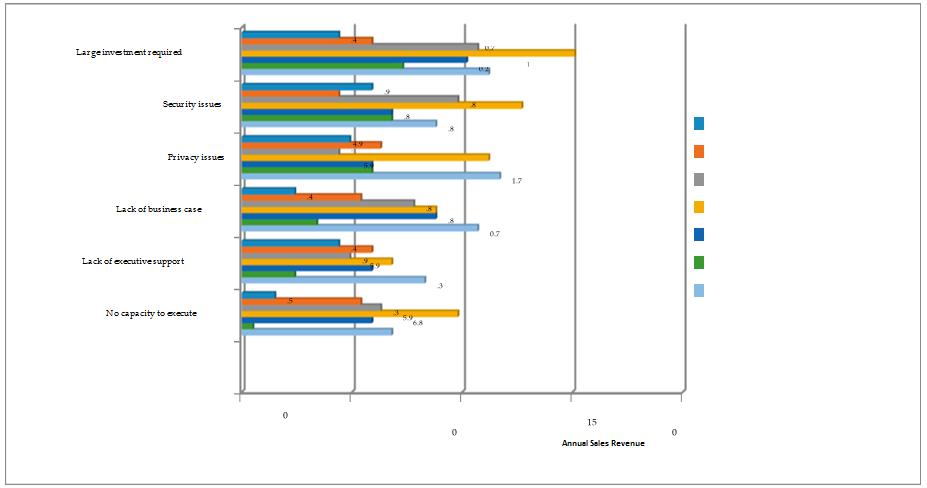
The second study target (O2) was the recognition and clarification of their key growth goals and organizations implementing a plan to incorporate BDA in SCM. Some differences between company sizes and BDA implementation strategy can be seen with the same chi-square test. The results of this study show that nine of the ten companies adopted a BDA strategy involving the SC; 23 companies (up to 248 workers) had not yet adopted a strategy (Table 3). The SC has not been involved in this strategy. The technique found in the sub-groups of over 50 workers is higher than expected (51 > 48.8, 61 > 54.2, and 46 > 40.8), with the BDA approach not possible (6.2 > 4, 6.8 > 0, and 5.2 > 0).
From the figure 2, it is pointed out that a company-wide strategy which includes, among others, the SC, 38.5 percent (79) of management of the companies included in the sample of surveys was adopted. Only 35.6% (73) of the companies surveyed had a BD supply chain strategy in place while only 11.2% (23) had somehow implemented the BD strategy.
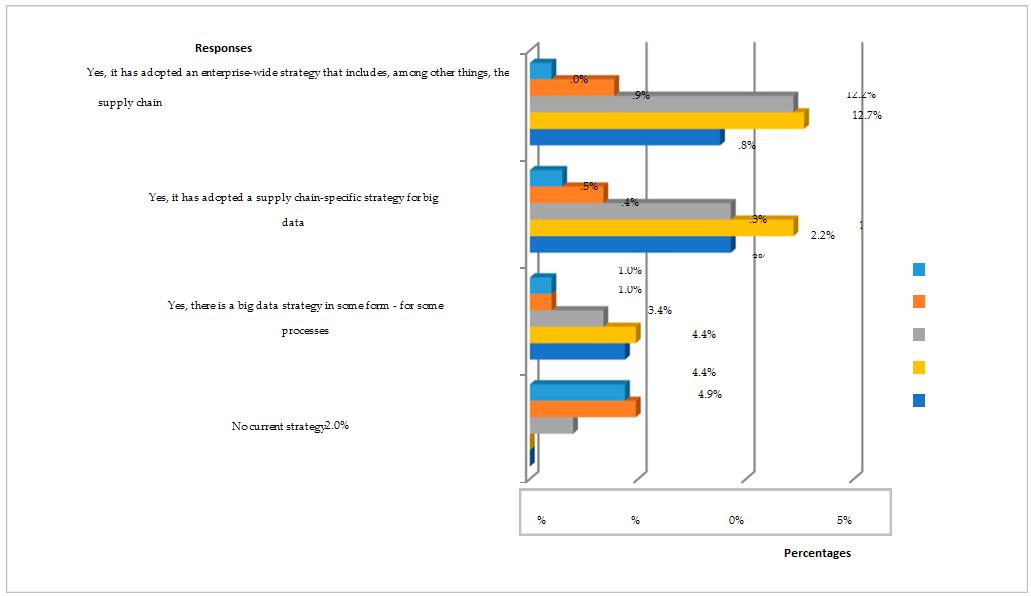
A chi-square (X2) check therefore supports the differentials, indicating that two variables are related (Table 4). It implies that we can assume, with a 95% likelihood, that there is a relation between the variables company size and plan for applying the BDA. X2calc's meaning is 65.0002, beyond X20.05.4= 9.49, so the hypothesis H2 is appropriate.

a Two cells (20.0%) have expected count less than 5. The minimum expected count is 1.80.
The determined coefficients (Phi, Cramer's and Contingency Coefficient) have minimal (close to zero) values, with definitions below 0.05, so we can consider a weak link between company size and BDA strategy (Table 5).
No. ofvalid cases
The results show that 24.2 percent of manufacturing companies have adopted a strategy that improves customer requirements predictions. Likewise, the main strategic targets to incorporate BDA are 7.1% of technology companies and 4.4% of online marketing businesses. Just consultancy firms (4.4 per cent) accept the importance of their own strategy to increase productivity of the supply chain (Figure 3).
Figure 3. Distribution of main development priorities of BDA for supply chain strategy according to industry
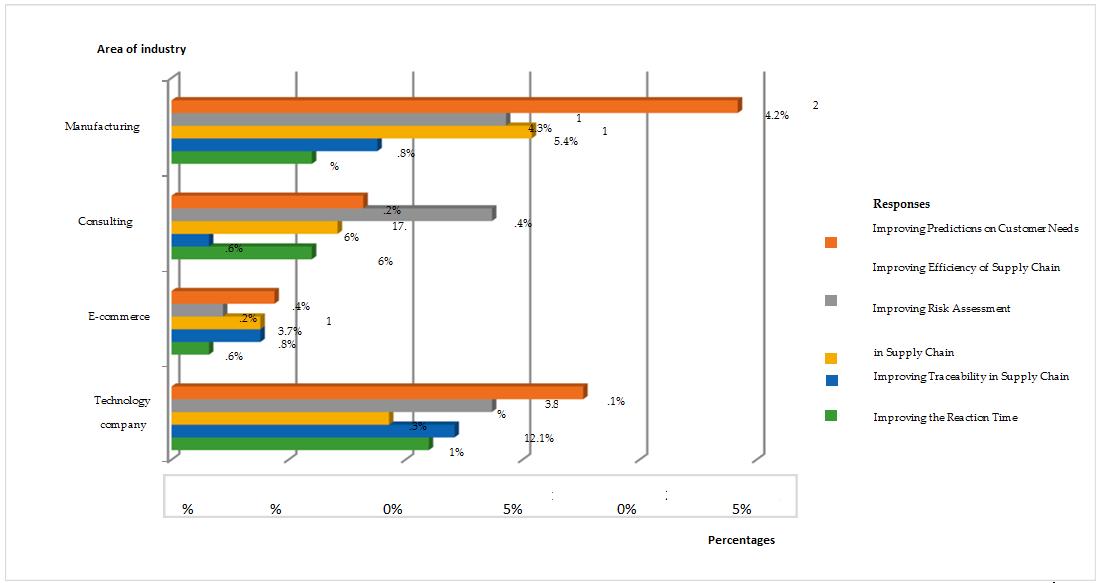
The third objective (O3) of study was to establish the professional skills needed to develop BDA perspectives.
Table 6 offers the distribution of businesses through the professional skills to gain insights through BDA based on years of working experience. 13 have experience on the Romanian market up to five years out of the 18 firms with no such professional capacity. Between 187 companies, 46.56 percent are domestically involved for up to 5 years and 26.2 percent for up to ten years. For the most part, this number is very high.
As shown in Table 6, the observed and predicted frequencies are separate but similar values within all subgroups generated by cross-purposing variables. The technical ability is higher than expected in organizations with a background of up to five years (40 > 37,4 and 87 > 85,7), with a consequent reduction in efficiency, if there is no capability, which is more than predicted in duration (3,6 > 1 and 8,3 > 7).
The essential ratio is 8,570, with the sense point at 0,036, less then p= 1,05 for the number of degrees of freedom df=3. The theory is therefore dismissed, and the alternative hypothesis agree that years of operational experience and professional skills are correlated with the creation of knowledge by BDA (Table 7).

a Three cells (37.5%) have expected count less than 5. The minimum expected count is 1.32.
Of the 68 companies, only 21.5% have up to five years of operational experiences and 9.7% have over five years, with their independence and a team of data specialists focused continuously on BDA. Four out of ten companies surveyed said that they had the expertise they needed to use highly advanced resources to obtain knowledge from an expert in the information technology or supply department (Figure 4). Through analyzing the answers of the executives, we could conclude that most organizations that did not use the technical resources of third parties either declined or were unable to recruit experts, qualified through specialized insight-generating methods, or that this goal was not included.
The fourth objective (O4) was to identify tools used to analyze supply chains and to implement the new tools and technologies for valuable insights into supply chains in the future.
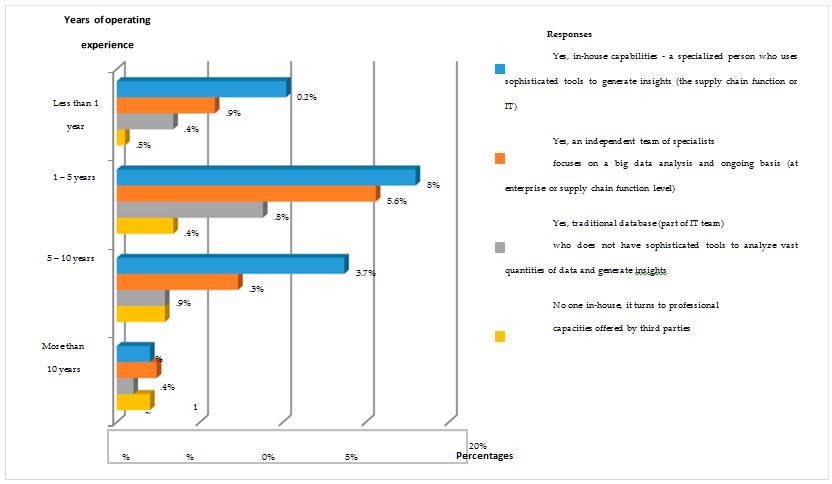
Organizations with a seniority of more than five years join the group of companies with less than 1 year and between 1 and 5 years. These are heavily linked to benefits like "improving customer service and demand fulfillment," "improved service prices," "enhancing supply chain quality" and "optimizing stock and asset profitability," and to "greater integration across the supply chain" and "optimizing inventory and asset-profit production".
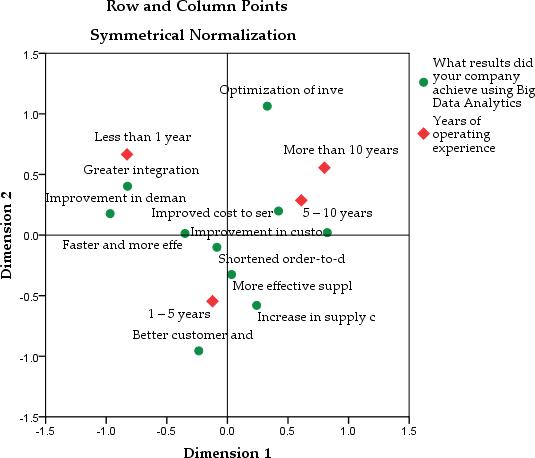
In contrast, the fewer advantages that companies operating on the market have been achieved for almost five years have been linked to "optimized inventory and asset productivity," "shortened delivery cycle times," "improvement in demandled operations," and "improved cost to serve".
The goal of the study (O6) was to evaluate the impacts on the potential purpose of businesses to implement the new tools and technologies to get valuable insight on the supply chain through practice, policy, technical capability, annual sales and business.
The discrete logistic regression model includes: expertise (x1), annual sales income (x2), policy (x3) and technical ability (x4) and market (x5). The following separate parameters (factorials) are included. For the testing of hypotheses, these variables are needed.
The dependent variable found in the model is calculated by businesses ' potential plan to implement new tools and innovations in order to obtain valuable insights into supply chain.
5. CONCLUSION
Massive quantities of data from multiple outlets have a positive impact on decision-making in real time. Big Data Analytics Implementation poses several problems with the diversity of data sources, optimized data quality and visualization. The findings show that 80% of Indian companies have gained experience in Big Data Analytics, embedding technology solutions into the supply chain. Significant operating budgets for large firms (which have more than 250 staff members) are provided for programs to incorporate big data processing in the supply chain or to recruit experts in the sector.
In fact, 90% of participants followed a corporate perspective (including the supply chain), encouraging the use of big data to create value to companies. Some of them have introduced a specific strategy for the supply chain (35.6%), while 11.2% have implemented a big data policy in certain structures for certain operations. A policy that is focused on the enhancement of predictions of consumer needs was implemented by some suppliers (24.2 per cent) and e-commerce businesses (4.4 per cent). Consultancies have as a goal an increase in supply chain quality. Indian companies want professional skills to create perspectives via big data analysis, with around 91.22% using such skills and being between 5 and 10 years old. Of these, 43.9% have a highly trained squad using advanced instruments to derive observations, 31.2% have a separate team and 16.1% have a standard database.
Firm executives acknowledge that technological developments have recently changed working processes, with investment in training and personnel development required for large-scale analysis. Firms having more than five years of market knowledge, including: "Enhancement of customer service and demand," "Enhancement of service costs," "Enhancement of supply chain effectiveness" and "Inventory and asset productivity optimisation" have achieved results from expertise. The outcomes of the "greater integration throughout the supply chain," "faster and effective time reaction to supply chain problems" and "optimizing inventory and asset efficiency" have been accomplished by other smaller and emerging businesses in Indian rural, assisted by teams of experts.
Executives agree that the transformation, administration and analysis of corporate information requires new capabilities and innovations. We have to confront the major challenges of embracing, using and controlling new technology. The most prominent issues are the complexity in processing of large numbers of data to produce correct results in good time. There is a need to build an architecture for Big Data Analytics that incorporates currently accessible data is based on the optimization, interoperability, protection, security, knowledge and financing.
Executives agree that new techniques, technologies and mathematical solutions such as cloud computing and encryption systems, to be intensively tested, are essential to their issues.Big data analysis is an opportunity to take advantage of new types of data to develop more flexible firms to address previously unsolvable problems which lead to better commercial results. It will contribute to a radical change in business activities, from the use of a system that is based solely on decision-makers ' knowledge to an intelligence model which gives the company and the enterprise itself real value.
REFERENCES
[1] Arunachalam, D., Kumar, N., & Kawalek, J. P. (2018). Understanding big data analytics capabilities in supply chain management: Unravelling the issues, challenges and implications for practice. Transportation Research Part E: Logistics and Transportation Review. https://doi.org/10.1016/j.tre.2017.04.001
[2] Chae, B. K., & Olson, D. L. (2013). Business analytics for supply chain: A dynamic-capabilities framework. International Journal of Information Technology and Decision Making. https://doi.org/10.1142/S0219622013 500016
[3] Govindan, K., Cheng, T. C. E., Mishra, N., & Shukla, N. (2018). Big data analytics and application for logistics and supply chain management. Transportation Research Part E: Logistics and Transportation Review https://doi.org/ 10.1016/j.tre.2018.03.011
[4] Gunasekaran, A., Papadopoulos, T., Dubey, R., Wamba, S. F., Childe, S. J., Hazen, B., & Akter, S. (2017). Big data and predictive analytics for supply chain and organizational performance. Journal of Business Research https://doi.org/10.1016/j.jbusres.2016.08.004
[5] Hazen, B. T., Boone, C. A., Ezell, J. D., & Jones-Farmer, L. A. (2014). Data quality for data science, predictive analytics, and big data in supply chain management: An introduction to the problem and suggestions for research and applications. International Journal of Production Economics. https://doi.org/10.1016/j.ijpe.2014.04.018
[6] Hazen, B. T., Skipper, J. B., Ezell, J. D., & Boone, C. A. (2016). Big data and predictive analytics for supply chain sustainability: A theory-driven research agenda. Computers and Industrial Engineering https://doi.org/10.1016/ j.cie.2016.06.030
[7] Huo, B. (2012). The impact of supply chain integration on company performance: An organizational capability perspective. Supply Chain Management. https://doi.org/10.1108/13598541211269210
[8] Ittmann, H. W. (2015). The impact of big data and business analytics on supply chain management. Journal of Transport and Supply Chain Management. https://doi.org/10.4102/jtscm.v9i1.165
[9] Pearson, T., & Wegener, R. (2013). Big data: The organizational challenge. Bain & Company https://doi.org/ 10.1073/pnas.1115621109
[10] Tiwari, S., Wee, H. M., & Daryanto, Y. (2018). Big data analytics in supply chain management between 2010 and 2016: Insights to industries. Computers and Industrial Engineering. https://doi.org/10.1016/j.cie.2017.11.017
